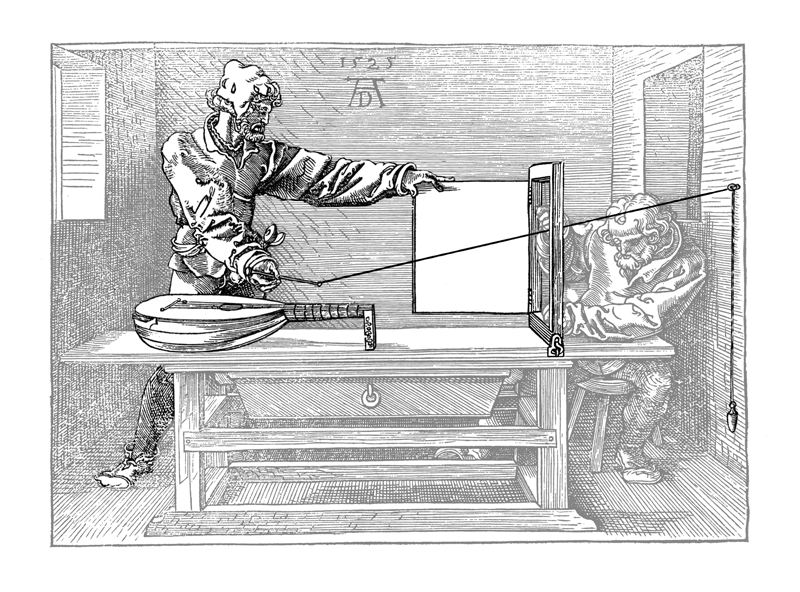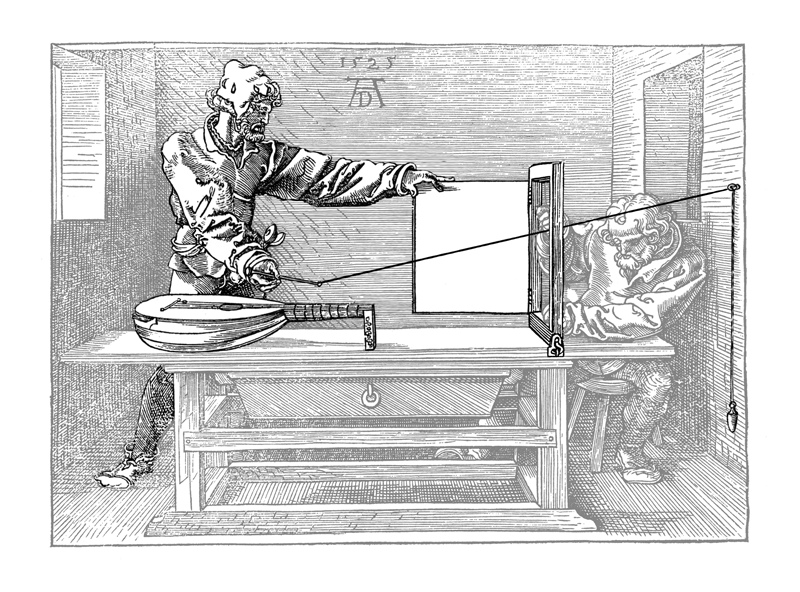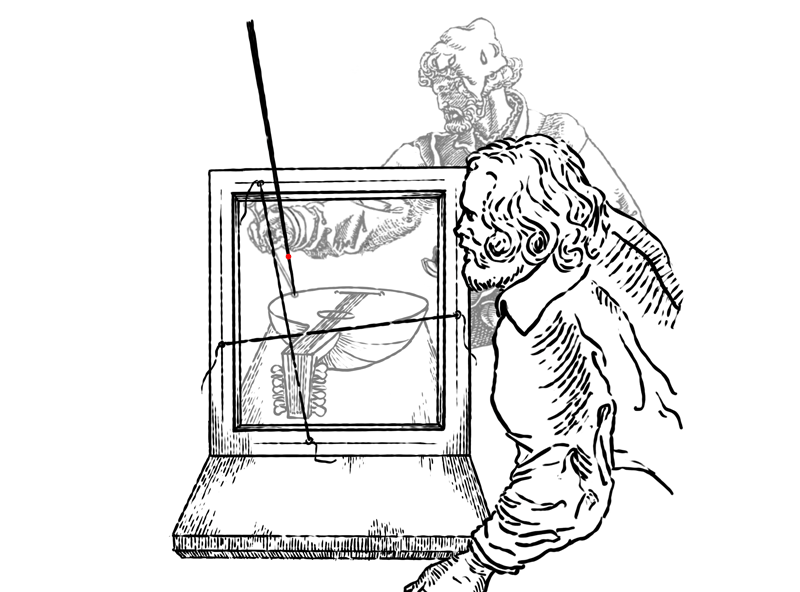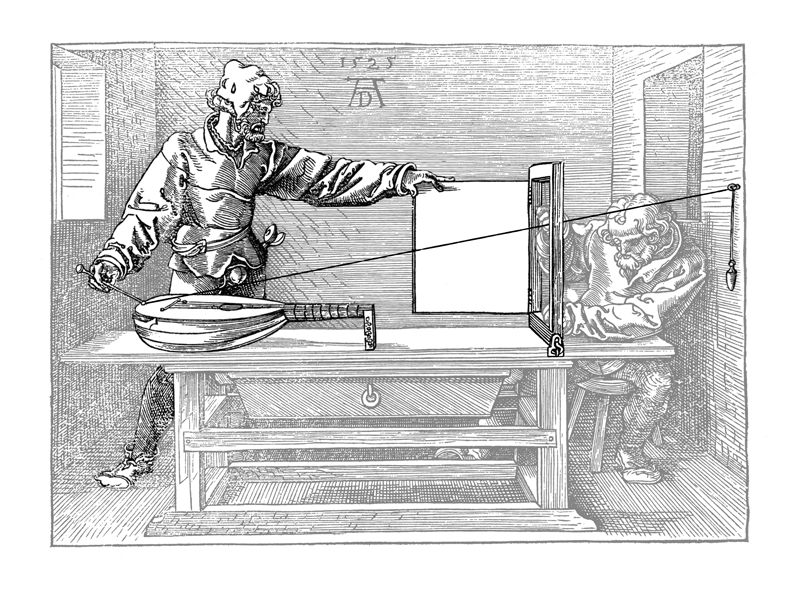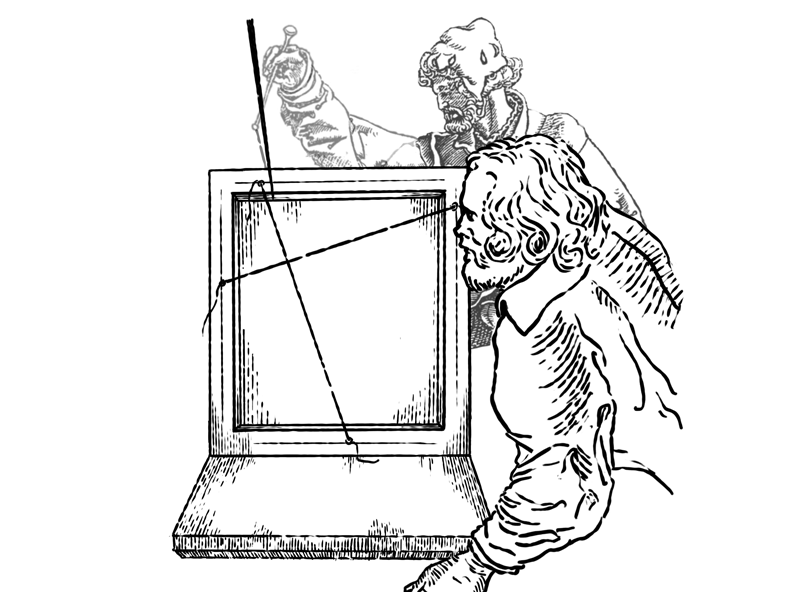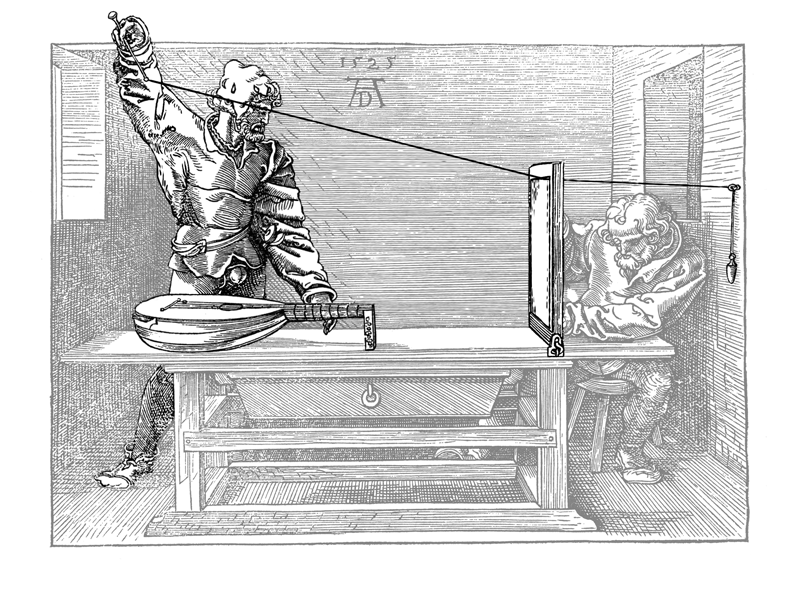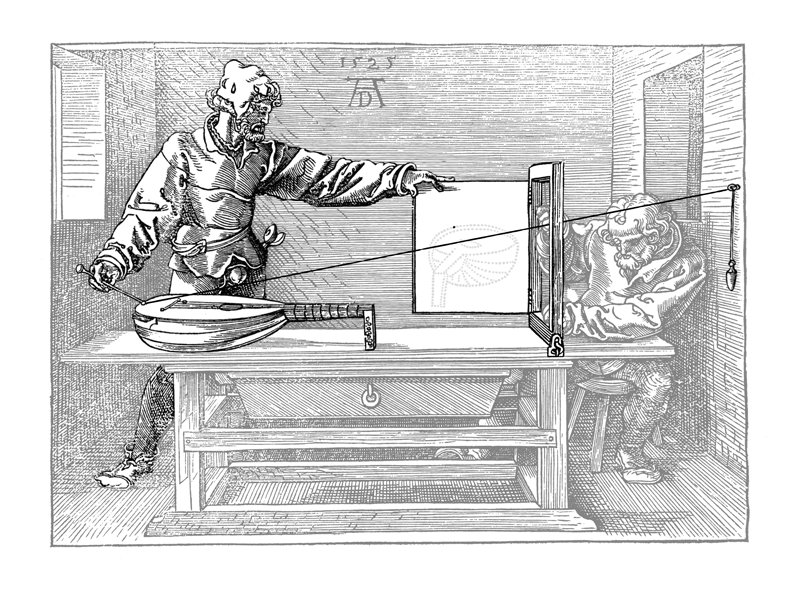[This is a mockup page for drawingmachines.org demonstrating new dynamic layout, animations and videos. Some links are inactive and are for layout purposes only]
Sportello (Dürer’s Door)
Sportello (Dürer’s Door), Albrecht Dürer (1525)
See this machine in the Timeline
(Inactive link. For mockup purposes only)
Machine Attributes
Select multiple tags to find machines with matching attributes
(Inactive tags. For mockup purposes only)
Description
Albrecht Dürer’s four-volume book Underweysung der Messung (1525) is an encyclopedic manual on geometry. The fourth volume focuses on linear perspective, relaying information Dürer gathered in his trips to Italy to learn from the Florentine artists who developed various methodologies for rendering realistic paintings. Even though Leon Battista Alberti published the mathematics for perspective construction in 1425, much of the technical development for the method was kept to a small circle of Italian artists.
Dürer’s treatise shows various devices based on previous technologies, but this device, depicting two men translating the complex geometry of a lute, is his own invention. Alternately called “Sportello” (“little door”) and “Dürer’s Door” (as a credit to its inventor), this device is quite laborious to operate. It is, however, a clear physical manifestation of the elements of linear perspective.
This image by mathematician Brook Taylor from 1719 outlines the basic construction of making realistic drawings. First establish the station point. This is where the viewer’s eye is positioned (Point “O”). Connect this point with a vector representing a line of light going from a point on your subject to the station point. Establish a picture plane representing the surface where the perspectival picture resides (Rectangle “GFIH”). The intersection of all the vectors with the picture plane represents an image that is the view of the subject from the station point. Dürer’s device turns these imaginary elements into a physical, functioning machine.
The machine is, effectively, a point plotter. One long string passing through the door frame (acting as the picture plane) is one ray of light connecting the eye (the hook on the wall) to one point on your subject (in Dürer’s image it is a lute). The final drawing is a series of many points you generate from repeating the sequence of actions until the entire subject is plotted.
Does the machine work? Yes. Is it practical? Absolutely not. There are many steps to merely draw one point. It requires two people to operate the devices. It is incredibly tedious. The lute drawing on the door in Dürer’s woodcut is made of 259 points. Even if the two operators were moving swiftly and could generate one dot every 30 seconds, this drawing would take over two hours!
This impracticality suggests that the Sportello’s great value was didactic. It easily demonstrates, in physical form, the principles of perspective. Taylor’s 1719 image outlines linear perspective’s geometric rules; Dürer’s Door imagines—in physical materials—a process of drawing that conforms with perspectival formulas.
Examples
Click thumbnail for archive entry for that machine (Inactive links. For mockup purposes only)
How It Works
This is the full sequence of operations for Dürer’s device. It requires two people working in concert to produce a drawing. Dürer describes the process:
“You can render anything within reach in correct perspective by means of three threads and draw it on a tablet as follows:
“If you are in a large chamber, hammer a large needle with a wide eye into the wall. It will denote the near point of sight. Then, thread it with a strong thread, weighted with a piece of lead. Now place a table as far from the needle as you wish and place a vertical frame on it, parallel to the wall to which the needle is attached, but as high or low as you wish, and on whatever side you wish. This frame should have a door hinged to it which will serve as your tablet for painting. Now nail two threads to the top and middle of the frame. These should be as long, respectively, as the frame's width and length, and they should be left hanging. Next, prepare a long iron pointer with a needle's eye at its other end, and attach it to the long thread which leads through the needle that is attached to the wall. Hand this pointer to another person, while you attend to the threads which are attached to the frame. Now proceed as follows. Place a lute or another object to your liking as far from the frame as you wish, but so that it will not move while you are using it. Have your assistant then move the pointer from point to point on the lute, and as often as he rests in one place and stretches the long thread, move the two threads attached to the frame crosswise and in straight lines to confine the long thread. Then stick their ends with wax to the frame, and ask your assistant to relax the tension of the long thread. Next close the door of the frame and mark the spot where the threads cross on the tablet. After this, open the door again and continue with another point, moving from point to point until the entire lute has been scanned and its points have been transferred to the tablet. Then connect all the points on the tablet and you will see the result. You can use this method for drawing other things. I have drawn this device below.”
From The Painter’s Manual, a 1977 reprint and English translation of Underweysung der Messung. Translation by Walter L. Strauss (Abaris Books, Inc. New York)
Step by Step Instructions
Step 1
Begin with the door open. Pull the baton through the door so it rests on an edge of your subject. The weight will keep the string taut.
Step 2
With the baton resting on one part of the subject, move the strings along the frame so that they intersect at the point where the long string crosses the frame.
The cross strings can be attached to the frame with any method as long as they are free to move and can be secured at specific locations. For example, the frame can have inset grooves where a sliding bolt holding one string end can be secured.
Dürer describes using wax to move and affix the strings, saying, “…move the two threads attached to the frame crosswise and in straight lines to confine the long thread. Then stick their ends with wax to the frame.”
Step 3
With the cross strings locked in place, move the long string out of the way and close the door.
It is unclear from Dürer’s description precisely how to move the long string out of the way. He says, “…ask your assistant (the baton holder) to relax the tension of the long thread.” The long string is attached to a weight to keep the string taut. The baton holder could pass the baton through the door to the other draughtsman. Or the frame draughtsman could hold the weight up, perhaps securing the weight on the hook to release the tension on the long string. Possibly, the simplest method is for the baton holder to raise the string to allow the door to close. If the door has a tiny gap at the top where it meets the frame, the door can easily close with the long string passing through. There is no documented evidence that this is the correct method, but repeated testing on a mockup device suggests this is an efficient way to easily clear the swinging door’s path.
Step 4
With the door closed, draw a mark where the strings intersect.
Step 5
After the mark is drawn, open the door. Lower the baton and begin the process again for a new location on your subject.
Step 6
Repeat steps 1-5, moving the baton to different locations around your subject until you have rendered an outline of your subject.












